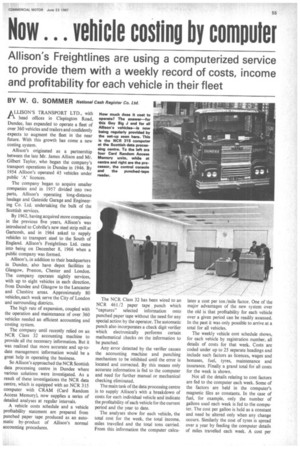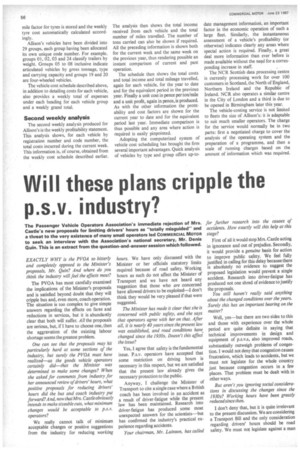Now • • • vehicle costing by computer
Page 57

Page 58

If you've noticed an error in this article please click here to report it so we can fix it.
Allison's Freightlines are using a computerized service to provide them with a weekly record of costs, income and profitability for each vehicle in their fleet
BY W. G. SOMMER National Cash Register Co. Ltd.
ALLISON'S TRANSPORT LTD., with head offices in Clepington Road, Dundee, has expanded to operate a fleet of over 360 vehicles and trailers and confidently expects to augment the fleet in the near future. With this growth has come a new costing system.
Allison's originated as a partnership between the late Mr. James Allison and Mr. Gilbert Taylor, who began the company's transport operations in Dundee in 1946. By 1954 Allison's operated 45 vehicles under public 'A' licences.
The company began to acquire smaller companies and in 1957 divided into two parts, Allison's operating long-distance haulage and Gateside Garage and Engineering Co. Ltd. undertaking the bulk of the Scottish services.
By 1962, having acquired more companies in the previous five years, Allison's was introduced to Colville's new steel strip mill at Gartcosh, and in 1964 asked to supply vehicles to transport steel to the South of England. Allison's Freightlines Ltd. came into being on December 8, 1966 when a public company was formed.
Allison's, in addition to their headquarters in Dundee, also have depot facilities in Glasgow, Preston, Chester and London. The company operates nightly services, with up to eight vehicles in each direction, from Dundee and Glasgow to the Lancaster and Cheshire areas. Approximately 80 vehicles,each week serve the City of London and surrounding districts.
The high rate of expansion, coupled with the operation and maintenance of over 360 vehicles needed an efficient accounting and costing system.
The company until recently relied on an NCR Class 32 accounting machine to provide all the necessary information. But it was realized that more accurate and up-todate management information would be a great help in operating the business.
So Allison's approached the NCR Scottish data processing centre in Dundee where various solutions were investigated. As a result of these investigations the NCR data centre, which is equipped with an NCR 315 computer with CRAM (Card Random Access Memory), now supplies a series of detailed analyses at regular intervals.
A vehicle costs schedule and a vehicle profitability statement are prepared from punched paper tape produced as an automatic by-product of Allison's normal accounting procedures. The NCR Class 32 has been wired to an NCR 461/2 paper tape punch which "captures" selected information onto punched paper tape without the need for any special action by the operator. The automatic punch also incorporates a check digit verifier which electronically performs certain mathematical checks on the information to be punched.
Any error detected by the verifier causes the accounting machine and punching mechanism to be inhibited until the error is located and corrected. By this means only accurate information is fed to the computer and need for further manual or mechanical checking eliminated.
The main task of the data processing centre is to supply Allison's with a breakdown of costs for each individual vehicle and indicate the profitability of each vehicle for the current period and the year to date.
The analyses show for each vehicle, the total cost for the week, the total income, miles travelled and the total tons carried. From this information the computer calcu
lates a cost per ton /mile factor. One of the major advantages of the new system over the old is that profitability for each vehicle over a given period can be readily assessed. In the past it was only possible to arrive at a total for all vehicles.
The weekly vehicle cost schedule shows, for each vehicle by registration number, all details of costs for that week. Costs are coded under up to 25 separate headings and include such factors as licences, wages and bonuses, fuel, tyres, maintenance and insurance. Finally a grand total for all costs for the week is shown.
Not all the details relating to cost factors are fed to the computer each week. Some of the factors are held in the computer's magnetic files as constants. In the case of fuel, for example, only the number of gallons used each week is fed to the computer. The cost per gallon is held as a constant and need be altered only when any change occurs. Similarly the cost of tyres is spread over a year by feeding the computer details of miles travelled each week. A cost per mile factor for tyres is stored and the weekly tyre cost automatically calculated accordingly.
Allison's vehicles have been divided into 29 groups, each group having been allocated its own unique code number. For example, groups 01, 02, 03 and 24 classify trailers by weight. Groups 05 to 08 inclusive indicate articulated vehicles by gross tonnage, type and carrying capacity and groups 19 and 20 are four-wheeled vehicles.
The vehicle cost schedule described above, in addition to detailing costs for each vehicle, also provides a weekly total of expenses under each heading for each vehicle group and a weekly grand total.
Second weekly analysis
The second weekly analysis produced for Allison's is the weekly profitability statement. This analysis shows, for each vehicle by registration number and code number, the total costs incurred during the current week. This information is, of course, obtained from the weekly cost schedule described earlier. The analysis then shows the total income received from each vehicle and the total number of miles travelled. The number of tons carried can also be shown if required. All the preceding information is shown both for the current week and the same week on the previous year, thus rendering possible an instant comparison of current and past operation.
The schedule then shows the total costs and total income and total mileage travelled, again for each vehicle, for the year to date and for the equivalent period in the previous year. Finally a unit cost in pence per ton/mile and a unit profit, again in pence, is produced. As with the other information the profitability and cost factors are shown for the current year to date and for the equivalent period last year. Immediate comparison is thus possible and any area where action is required is easily pinpointed.
Adopting the computerized system of vehicle cost scheduling has brought the firm several important advantages. Quick analysis of vehicles by type and group offers up-to date management information, an important factor in the economic operation of such a large fleet. Similarly, the instantaneous assessment of a vehicle's profitability (or otherwise) indicates clearly any areas where special action is required. Finally, a great deal more information than ever before is made available without the need for a corresponding increase in staff.
The NCR Scottish data processing centre is currently processing work for over 100 customers in Scotland, the North of England, Northern Ireland and the Republic of Ireland. NCR also operates a similar centre in the City of London and a third is due to be opened in Birmingham later this year.
The vehicle-costing service is not limited to fleets the size of Allison's: it is adaptable to suit much smaller operators. The charge for the service would normally be in two parts: first a negotiated charge to cover the analysis of the operating system and the preparation of a programme, and then a scale of running charges based on the amount of information which was required.












































































































